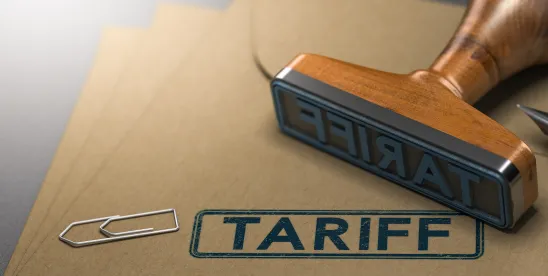On February 1, 2025, President Trump issued three executive orders imposing tariffs on nearly all imports from Canada[1], Mexico,[2] and China.[3] However, on February 3, the President said on social media that the tariffs on Canada and Mexico will be suspended for one month while the countries discuss potential agreements to reduce or rescind the tariff imposition.[4] A subsequent federal register notice provides details of the China tariffs.[5]
So, at the time of this publication, only one of the three new sets of tariffs have gone into effect: those adding a 10% duty on nearly all imports from China to the United States. Under the executive order, the 10% additional duty is added to “any other duties, fees, exactions, or charges applicable” to goods from China.
1. The China Tariffs[6]
While the U.S. tariffs on China appear to be a continuation of President Trump’s first-term (Trump I) measures against Chinese imports, they bear some notable differences that may show us much about the tactics and effects of this renewed trade war.
1.1 The Consumer Impact
In 2018, the first Trump administration’s tariffs on China (imposed under Section 301 of the Trade Act) were estimated to have added an additional cost of $14 billion to domestic consumers and importers in that year alone.[7] So we expect that, in the short term, we will see a rise in consumer product prices as importers pass the costs of paying the tariffs on to their customers.
Moreover, many consumer items imported directly from China were protected from the Section 301 tariffs by application of the standard de minimis rule on imports. Under that rule, any import valued at less than $800 is not normally subject to tariffs. The application of that rule to the Section 301 duties eased the effect on many consumers, including the vast quantity of Chinese-origin goods that Americans purchase through e-commerce channels.
By contrast, the executive orders implementing these new tariffs expressly state that the de minimis protection will be unavailable. Moreover, it appears from our reading of the orders that the de minimis rule will be unavailable for the older Section 301 tariffs in addition to the new tariffs. As a result, total tariffs of up to 35% on goods from China (up to 25% Section 301 duties from Trump I, plus the 10% tariffs now imposed in the new administration), will apply to all subject Chinese imports, regardless of how small the value. A trade association has noted that without de minimis the average $50 package would more than double the delivery cost. That means the tariffs are more likely to show up in the bottom line of U.S. households, which purchase billions of dollars in Chinese consumer goods each year.
1.2 National Security Concerns
You may recall that in the first Trump presidency, we reported on several rounds of China tariffs (in fact, we kept a China Trade War Scorecard . . . which will need some updating). As we noted above, those tariffs were imposed under Section 301 of the Trade Act of 1974, which allows the executive branch to respond to foreign countries’ unfair trade practices by imposing measures including substantial tariffs.
Interestingly, President Trump has invoked a different law for the current wave of tariffs: the International Emergency Economic Powers Act (IEEPA).[8] Traditionally, IEEPA is used to impose export controls and economic sanctions to protect U.S. national security. Unlike other tariff laws[9] which impose time-consuming procedural steps, IEEPA allows the president to impose measures quickly and easily, requiring only a declaration of a national emergency under the National Emergencies Act (NEA) and an annual renewal.
But IEEPA has never before been used to impose tariffs. For that reason, President Trump’s use of IEEPA for these tariffs may face legal challenges. Some reports have indicated that certain Trump administration personnel were cautious to impose tariffs under IEEPA, reportedly citing the possibility that opponents of the measure could seek injunctions. However, courts have generally been deferential to a president’s use of national security powers for trade measures.
1.3 Exclusions and a Few Other Details
Humanitarian and Communications Imports. Humanitarian donations, informational materials, and personal baggage are exempted from the tariffs. This is because IEEPA prohibits its use to regulate or prohibit any personal communication “which does not involve a transfer of anything of value”, humanitarian donations, informational materials, and any “transactions ordinarily incident to travel”.
Duty Drawback Unavailable. The Executive Order implementing the China tariffs notes that no duty drawback will be available for duties paid under this Order.
U.S. Foreign Trade Zones. The Order also states that goods subject to the China tariffs and admitted into a U.S. Foreign Trade Zone (FTZ) fall under a “privileged foreign status”. Thus, the new tariffs will not apply until and unless the articles are later withdrawn from the FTZ for consumption.
Entry of Mail. The federal register notice states formal entry would be required for all mail shipments from China and Hong Kong. After suspending service for those regions, the U.S. Postal Service (USPS) announced it would resume accepting inbound mail and packages from China and Hong Kong. USPS posted a notice that it was working with Customs and Border Protection to “implement an efficient collection mechanism for the new China tariffs to ensure the least disruption to package delivery”.
2. The Canada and Mexico Tariffs
2.1 Canada (10% on energy and energy resources and 25% on all other goods of Canadian origin effective March 4, 2025)
Imports from Canada will be subject to an additional 25 percent tariff on “all articles that are products of Canada” other than “energy or energy resources”, which will be subject to a 10 percent rate of duty. See Executive Order Imposing Duties To Address The Flow of Illicit Drugs Across our Northern Border (February 1, 2025). Energy and energy resources means “crude oil, natural gas, lease condensates, natural gas liquids, refined petroleum products, uranium, coal, biofuels, geothermal heat, the kinetic movement of flowing water, and critical minerals”. See Executive Order 14156 (January 20, 2025). The effective date of these tariffs was delayed from February 4 to March 4. See Executive Order Progress on the Situation at Our Northern Border (February 3, 2025).
The federal register notice was initially posted, but later withdrawn.
2.2 Mexico (25% on goods of Mexican origin effective March 4, 2025)
Imports from Mexico will be subject to an additional 25 percent tariff on “all articles that are products of Mexico.” See Executive Order Imposing Duties To Address The Situation At Our Southern Border (February 1, 2025). The Department of Homeland Security (DHS) will publish a Federal Register notice shortly with additional details and an update to the Harmonized Tariff Schedule of the United States (HTSUS), but these tariffs appear to apply to all items country of origin Mexican imported into the United States. The effective date of these tariffs was delayed from February 4 to March 4. See Executive Order Progress on the Situation at Our Southern Border (February 3, 2025).
Because of the temporary suspension of the two tariff regimes, we will save further details of those prospective tariffs for another article.
3. International Reactions
3.1 China – Retaliatory Tariffs and More
On February 4, 2025, China announced its own set of countermeasures. Effective February 10, 2025, China will impose a 15 percent tariff on liquefied natural gas and coal and a 10 percent tariff on crude oil, pickup trucks, agricultural machinery and large-displacement cars.
China will also impose additional export controls on several critical minerals essential to U.S. economic or national security including tungsten, tellurium, bismuth, molybdenum and indium.
Other U.S. companies may also get caught in the cross-hairs. China’s State Administration for Market Regulation announced an investigation into a U.S. company and China’s Commerce Ministry placed two additional U.S. companies on its unreliable entities list.
3.2 Canada – Measures to Precipitate a Suspension of Tariffs
On February 1, 2025, Canada announced imposing a 25 percent tariff on an initial list of American goods to be effective February 4, 2025. A second extended list was also reportedly under consideration. Other retaliatory measures were in the process of being implemented in different provinces, such as a ban on American alcohol. However, Prime Minister Trudeau announced that Canada would increase personnel at its border with the United States to combat the flow of fentanyl. Trudeau will also appoint a fentanyl czar and list cartels as terrorists. It appears that those actions precipitated a suspension of the U.S. tariffs which resulted in Canada pausing its retaliatory tariffs.
3.3 Mexico – Measures to Precipitate a Suspension of Tariffs
While Mexican President Claudia Sheinbaum did not initiate any retaliatory tariffs, Sheinbaum announced the deployment of 10,000 National Guard members to Mexico’s northern border to reduce illegal migration and drug trafficking. That action appears to have precipitated a suspension of the U.S. Tariffs on Mexico.
4. What Comes Next
The ever-changing landscape will make it difficult for companies to insulate supply chains from the impact of these new tariffs. The new tariffs may lead to alternative sourcing from non-targeted countries. But for products like batteries, machinery, and toys, we might not see these tariffs soften Chinese imports. We also expect to see CBP increase enforcement on circumvention attempts regarding declared country of origin.
We may expect to see further tariff developments over the next month should the Trump administration determine that the Canadian and Mexican cooperative actions are not sufficient.
In fact, there could be more tariffs on other countries in the horizon.[10] We will continue to monitor developments in tariffs and report them here. For a broader scope on all of Trump’s Executive Orders, please see our dedicated tracker.
FOOTNOTES
[1] Executive Order Imposing Duties To Address The Flow of Illicit Drugs Across our Northern Border (February 1, 2025).
[2] Executive Order Imposing Duties To Address The Situation At Our Southern Border (February 1, 2025).
[3] Executive Order Imposing Duties To Address The Synthetic Opioid Supply Chain in the People’s Republic of China (February 1, 2025).
[4] In fact, we apologize for the delay in publishing this article, but we kept having to go back rewrite the piece a fair few times over the course of 24 hours!
[5] Implementation of Additional Duties on Products of the People’s Republic of China, available here.
[6] We note the executive order and federal register notice imposing tariffs and other measures on China include Hong Kong.
[8] 50 U.S.C. 1701 et seq.
[9] Section 301 of the Trade Act of 1974, Section 201 of the Trade Act of 1974, Section 232 of the Trade Expansion Act of 1962, and Section 338 of the Tariff Act of 1930. We note that Section 122 of the Trade Act of 1974 does not require any related investigation or procedural steps, but only allows the president to impose up to a 15 percent tariff on imports for 150 days.
[10] President Trump has recently threated 100 percent tariffs on countries that are members of the BRICS coalition (which includes Brazil, Russia, India and China) should they follow through with their plans to create a gold-backed currency alternative to the U.S. dollar.







 />i
/>i

